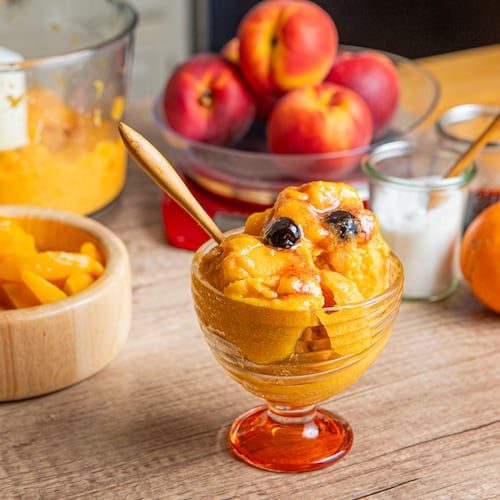Most of the produce that Atlanta area community-supported agriculture subscribers receive in their weekly local farm shares is organic. But one regular exception is North Georgia apples, a welcome treat this time of year that come with all the turnips and cabbages and braising greens.
The apples are often labeled “nonorganic,” “minimal spraying” or “IPM.” What does it mean? Why can’t our local apples be organic, too?
“In the South, it’s very difficult,” explained Michael Wheeler, the University of Georgia’s Gilmer County Cooperative Extension agent. “In the South, it’s just hot and humid and it rains. So using fungicides [and other chemicals] is something we have to do in order to produce a marketable product to the public.”
So the compromise between organic and full-on chemical abandon is a concept called integrated pest management, or IPM. The idea is to use a minimal amount of chemicals to the greatest effect. With the Cooperative Extension’s help, growers do this by zeroing in on the biggest threats — in this case, a few kinds of moth larvae and a bacterial disease called fire blight — with a combination of targeted chemicals, computer modeling and careful monitoring of the weather and insect populations.
Each growing season, Wheeler keeps close track of daily temperatures and precipitation, plugging the numbers into a computer program to predict when it’s time to spray for fire blight. The agency also tracks temperatures and moth populations (an “apple scout” sets traps in participating orchards to count the critters) to plot when to spray for various harmful larvae.
Wheeler describes today’s fungicides, insecticides, herbicides and the like as GPS-guided missiles. “They’re not just World War II-era bombs that they threw out in hopes to hit Dresden. These are more like precision guided missiles. But they’re only effective during certain times of the life cycle, and we’ve got to use them wisely.”
With today’s IPM program, Wheeler estimates that growers have reduced spraying by 25 percent. “Back in the day before IPM, they would spray every 10 to 14 days whether they needed it or not,” he said. “Now there may be times where they go 30 days without an insecticidal spray.”
Most important, those sprays are killing only the creatures that are a direct threat to the apple industry and leaving the rest alone.
Wheeler recalled a conversation he had this summer with a grower who mentioned that his orchard was teeming with insect life.
“He said, ‘I don’t know if it’s a good thing or a bad thing, but we’ve got the bugs now.’
“And I think that’s just great,” Wheeler said. “It’s showing that we’re not harming 99 percent of the bugs out there. We’re just targeting what we need to target and still producing a decent apple.”
They are more than decent. They are excellent, and the main source of the desserts being created in my kitchen right now. I’m glad to have them. And I’m glad to know that in their wake are bugs in my growers’ orchards.
At local farmers markets
Apples, arugula, beets, bok choy, broccoli, cabbage, carrots, cauliflower, collards, eggplant, herbs, kale, horseradish, Jerusalem artichokes, jicama, lettuce, mixed greens, mustard greens, parsnips, pecans, peppers, potatoes, radishes, shiitake mushrooms, sweet potatoes, Swiss chard, turnip greens, turnips, winter squash
From farther afield
Looking good: Apples, Florida and Chilean avocados, Georgia beans, Mexican beets, California and Mexican broccoli, Mexican brussels sprouts, cabbage, Michigan and California carrots, California cauliflower, California and Georgia corn and eggplant, Georgia and Carolina greens, Texas grapefruit and oranges, Washington pears, Florida and Mexican summer squash, Florida tomatoes, Mexican watermelon
Coming in: South American blueberries, Florida corn and eggplant, South American grapes, Arizona oranges, Mexican raspberries, Florida watermelon
Variable quality: Caribbean and Mexican blackberries, Mexican carrots, California and Caribbean peas, California tomatoes
Local reports and the Packer
---------------------
Easy Apple Pastries
Hands on: 20 minutes Total time: 55 minutes Serves: 6
These individual tarts are easy, elegant and delicious. The recipe is adapted very slightly from one that appeared in Bon Appétit in March 2004.
6 frozen puff pastry shells, thawed
2 medium apples, peeled, quartered, cored and very thinly sliced
2 tablespoons unsalted butter, melted
3 tablespoons granulated sugar
Scant 1/2 teaspoon ground cinnamon
1/4 teaspoon ground ginger
1/4 cup apricot jam, melted
Preheat oven to 400 degrees. Line a baking sheet with parchment paper. Place the shells on the parchment paper, several inches apart. Using a rolling pin, in two or three strokes, roll the shells to about 6 inches in diameter. With the tines of fork, pierce the center of each shell 4 or 5 times. Arrange as many apple slices as you can in the center of each shell, overlapping apple slices but leaving the border clear. Brush the apples with melted butter.
In a small bowl, combine sugar, cinnamon and ginger. Sprinkle the apples with the sugar mixture. Bake 20 to 25 minutes, until puffed and lightly browned. Gently brush the melted jam over the apples. Return the pastries to the oven and bake 2 to 3 minutes longer. Serve warm or at room temperature.
Per serving: 378 calories (percent of calories from fat, 52), 4 grams protein, 43 grams carbohydrates, 2 grams fiber, 22 grams fat (5 grams saturated), 10 milligrams cholesterol, 125 milligrams sodium.
About the Author
The Latest
Featured

